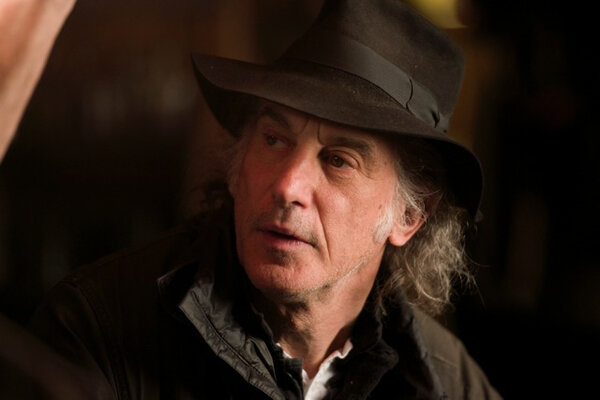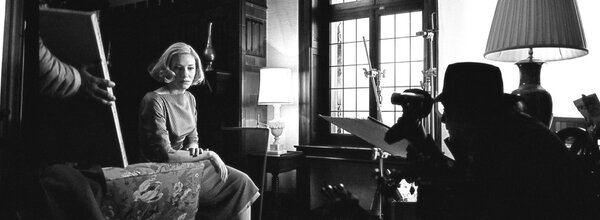Cinematographer Ed Lachman, ASC, speaks about his work on Todd Haynes’s “Carol”
A poetic and realist film
What story were you and Todd Haynes trying to tell ?
Ed Lachman : To put it in a bit of context, the film was adapted from a novel by Patricia Highsmith, The Price of Salt. It isn’t the author’s best known work, as her reputation is largely based on crime fiction novels. In this story, the crime isn’t really a crime, but rather the passion shared by two women. A thing which, when the novel was written in 1949, didn’t at all have the same connotations it does these days.
The story takes on the point of view of the younger of the two protagonists, Therese (played by Rooney Mara in the film), who inspired me right from the start because she reminds me a lot of Vivian Maier. A girl who slaves away as a low-level sales assistant in a department store, but who is a photographer on the side. Her photos are fairly abstract city shots which capture the city’s shadows, its landscapes, its parks rather than its residents. And, as the plot develops and she gets involved in this relationship, she begins to photograph its people. It’s almost the same path that Vivian Maier took, with all of the self-portraits, and the way she had of seeing herself and projecting that self onto the world that surrounded her.
Your influences ?
EL : We watched quite a number of films. Not so much to inspire us stylistically, but more in terms of cinematographic language. Most notably A Place in the Sun by George Stevens, a film with a very prominent point of view in terms of narration, one that he sticks to for the entire length of the film. L’Eclipse by Antonioni, as well, or L’Avventura, which blends several points of view quite elegantly, both objective and subjective, in its attempt to reveal the characters mainly through their environment. And then, I’d also like to mention the work of some photographers who are very dear to me, like Robert Franck, and especially Saul Leiter, who created an abstract vision of urban reality.
A few years ago, the two of you worked together to bring another story to the screen, one that took place in the same era. Are there visual links between the two films ?
EL : No. To be honest, it’s actually kind of the opposite from what we did on Far from Heaven. The image takes on a documentary approach, but no hand-held camera. The images quite simply needed to look like people could have been able to film them in the 1950s.
Which is why we shot in Super 16, so we could find the picture character that was appropriate to the era. Modern 35mm film was actually much to fine to end up with that on the screen. It actually turned out to be a visual layout that was pretty close to what we had already experimented with on Todd’s television series Mildred Pierce.
16mm… in 2015 ? Did I hear that right ?
EL : Well I’ve got to be honest with you : I’m a great advocate of film. For me, there’s a kind of presence when you’re shooting on film… For example, all sorts of manufacturers or advocates of digital filming will put forward the argument that digital looks more and more like actual film, but it’s never the other way around ! Well, other than Michael Mann, who likes to be a bit inflammatory !
The three layers of emulsion play a large role in the combining of the colors and how they turn out, the way the lights blend at different temperatures…And the picture character, the grain that changes position in each frame… How the film is threaded through the camera… All of this gives a feeling that in my opinion just can’t be digitally reproduced.
Where did you shoot ?
EL : The film is supposed to take place in New York during the 1940s, and seeing that it was after all a small budget, we weren’t able to incorporate a lot of digital effects into the longer takes. It turns out that Cincinnati, Ohio, is a surprisingly perfect backdrop for that. Not only the skyline of the old city, which is very reminiscent of New York shortly after the war, but what’s more, believe it or not, you find all sorts of people there whose style and look can totally pass, in the background, for that of people from the 40s ! A true low-cost time machine !
Can you give us some specs on the equipment ?
EL : We shot with an Arri 416, and for the most part I mounted it with an old Cooke 20-60mm zoom, which I love. We also had an Angenieux 25-250mm and an Arri Master Zoom 16.5-110mm. For the fixed lenses, I used a few Cooke Panchros that are 30 or 40 years old, and of course without any diffusion because in 16mm, we are after all trying to preserve all of the definition the film can capture !
One thing I wasn’t expecting was the difficulty we had trying to find a second assistant camera there, one who still knew how to load film ! Finally we had to bring in a girl from Cleveland, because on site there wasn’t anyone who still knew how to do it…
OK… the aggravating question. Tell us about the lab ?
EL : That’s the saddest part. The film was developed in New York at Technicolor shortly before they closed down. We only got the rushes once a week and I watched them each Sunday. When the film was done, I learned that the lab was closing, and, astonished, I went and asked them what was going to become of all the equipment, the continuous processors…
I was told that everything would most likely be tossed in the dumpster, simply because nobody wanted any of it.
Can you imagine that, dragging an entire continuous processing and printing rig to the dump, some $250,000 worth of equipment, at least ! That really made me feel awful.
I called my key grip and I asked him if he had a bit of room in the warehouse where he keeps his gear… We picked up the whole lot of it, and as a result, I am now the owner of a dismantled photochemical laboratory, waiting to be reassembled… I don’t really know right now what I’m going to do with it, but I’m trying to hold on to it. Long enough that people return to their senses in this country !
It’s true, we still have three active photochemical labs in Paris, and there are none left in New York !
EL : I truly can’t understand this situation. According to my research, at least 25% of Hollywood films are still shot on film, blockbusters and superhero films included. So there is a real market for film processing… How is it possible that the executives in New York have suddenly decided to close a lab under the pretext that there isn’t any work, without thinking that it might take off again three or four months later ? Sure, you also have to take into consideration the price of real estate in New York, which has become exorbitant. Which makes me think that if something should reappear on the East Coast, it’s bound to be in a small town in the suburbs so it can be economically viable.

What about lighting, what strategies did you adopt ?
EL : When light enters a room, it doesn’t only touch the actors ! It fills the space. That is why I try, above all, to light the space itself before I let the actors evolve inside it. In Carol, many of the scenes were shot with two cameras because of time constraints. And so it was absolutely necessary for me to integrate these parameters of flexibility into the plan, allowing the maximum amount of light to permeate the set or to pass through the windows.
A last word on the film stock you used ?
EL : I dipped into the full spectrum of what I still had available to me. 50D and 250D for daytime exteriors, 200T and 500T for interiors. What I also like with film is that it’s me, my light meter and the processing that control everything. There is no middle-man between me and the image, as can sometimes be the case with digital, with that great nonsense, the 14 stops of leeway they’re always harping on about. 14 stops… Can you believe that ? What are you supposed to do with that ?
(Interview conductaed by François Reumont for the AFC, and translated from French by Chris Clarke)
- Carol won the Camerimage 2015 Golden Frog.
 En
En Fr
Fr





